Abstract
Geographical and environmental conditions were two of the most important factors on the design and construction of traditional architecture. Traditional earthen architecture is found throughout the Iberian Peninsula in numerous constructive techniques and variants, most notably rammed-earth, adobe and half-timber. The varied morphology, climate, geology and culture of the Iberian Peninsula, together with its immediate surroundings, have a direct effect on the development and the properties of traditional architecture. Thus, the objective of this research is to establish the relationship between the geographical characteristics and the distribution of the earthen techniques. For that purpose, the authors of this text have carried out a thorough data collection throughout the whole of the Iberian Peninsula in order to identify the main characteristics of this architecture in each location and to produce maps featuring the locations for each technique. This mapping of numerous techniques has been compared with other thematic maps of the territory, establishing relationships between the different techniques and specific properties of a given area. These provide hypotheses on which factors encourage or hinder the use of earthen construction techniques. Moreover, the relationship of traditional architecture with geographical factors and its specific morphology on a given place has provided many design lessons for a sustainable architecture. Those lessons must be taken into account on rehabilitation works and new architecture.
1. Introduction
The Iberian Peninsula in southwest Europe includes the territories of Spain, Portugal, Andorra and United Kingdom (Gibraltar), although this study is limited to Spain and Portugal, which occupy almost the entire Peninsula with an approximate surface area of 582,000 Km2. Throughout history, the Iberian Peninsula has acted as a base and home to many cultures. Those cultures have influenced and enriched the configuration of its urban nuclei and architecture. These have adapted and optimised the constructive solutions which were eventually imported from these individual cultures to specific locations. The influence of the occupation of the Peninsula brought about variations in traditional architecture, as evidenced by its expansion throughout the territory and the geoclimatic features of individual locations [1].
The geography and culture of the Iberian Peninsula are very heterogeneous. Geographically it is worth noting five mountain ranges (Cordillera Cantábrica and the Pyrenees in the north, Sistema Central and Sistema Ibérico in the central region and Sistema Bético in the south), which divide the territory into two plateaus (north and south), creating the main river valleys (Ebro, Tajo, Duero, Guadiana and Guadalquivir). The Peninsula is also surrounded by two very different seas: the Atlantic Ocean in the West, North and part of the South and the Mediterranean Sea in the East and Southeast, directly affecting its climate.
The Iberian Peninsula has a wealth of earthen architectural heritage, one of the greatest in Europe [2,3]. Traditional architecture includes frequent examples of great diversity and size. This architecture is also found in all types of buildings, both individual and in groups in rural and urban nuclei, and fulfilling different functions (residential, agricultural, manufacturing, etc.)
Different factors including the varied climate, morphology, geology, culture and materials to be found in the Iberian Peninsula also give rise to an extremely varied traditional architecture, closely linked with these characteristic external factors in each given location. Furthermore, other specific aspects, such as building location, position in relation to the sun, shape, distribution and constructive techniques used, are also linked to these factors and are a response to the optimisation of available resources, the result of human learning and development in a specific location. Traditional earthen architecture and constructive techniques have gradually adapted to the conditioning factors and materials available in individual locations and a wide range of constructive solutions, techniques and variants can now be distinguished.
The study of earthen techniques and their distribution on the territory of the Iberian Peninsula provides hypotheses on which factors encourage or hinder their use. The adaptation of traditional architecture to its environment through the construction techniques and its specific morphology has provided many design lessons for a sustainable architecture. Those lessons must be taken into account on rehabilitation works and new architecture.
2. Traditional Earthen Architecture in the Iberian Peninsula
The documentation of traditional earthen architecture in the Iberian Peninsula began with the study of the general literature on traditional architecture, and on specific traditional earthen construction techniques, complementing these with extensive fieldwork of the buildings found throughout the Peninsula [4,5,6,7]. All the information and data collected has been also supplemented and verified with several papers from the proceeding of the main conferences [8,9,10,11,12,13]. Generally, those papers are focused in concrete and small areas whose information has been very important on the development of the research.
All the information compiled was organised into database fiches, making it possible to work efficiently and methodically to establish relations between the characteristics of the different case studies and to classify the different constructive techniques and variants found in the Iberian Peninsula [14]. This comprehensive study was carried out through the analysis of the use of all the materials in individual techniques and variants, covering general to specific aspects in logical succession to assess as many combinations as possible.
The classification methodology for earthen construction techniques in traditional architecture was based on an initial classification into three major groups:
- Earth in massive walls: these are compact, homogeneous and jointless walls (or at least walls with unmortared joints). Techniques include rammed-earth, cob and excavated architecture. In this group it is worth highlighting the rammed-earth technique, found throughout almost all the Peninsula [15,16].
- Earth in walls in pieces: these are masonry walls with a great variety of bonding agents made up of pieces, which can differ greatly in size and composition. This group includes adobe, sod and cut earthen blocks. In earthen masonry walls mostly prevails the use of adobe technique, found in almost all the Peninsula, but predominantly in the Northern half [17].
- Earth in half-timber: this is a mixed technique consisting of a timber framework with an earth infill, both with very different properties. Variants for this technique depend on the characteristics of the timber structure and the filling. This type of technique is found mostly in the north of the Iberian Peninsula and is less frequent than rammed-earth or adobe.
3. Objectives and Methodology
Knowledge of the most important techniques and variants in the Iberian Peninsula, and their location, are the starting point for this study. Its main aim is to provide a detailed analysis of the relation between the most common techniques in the field of study (rammed-earth, adobe and half-timber) and the characteristics of the areas in which these are found. The link between traditional earthen architecture and the geography of each location makes it possible to examine the factors encouraging or hindering earthen construction throughout the territory.
The study is based on the data recorded through several data collection campaigns throughout the entire Iberian Peninsula. From this work, the existence of earthen constructions has been identified in 618 locations, where one or several techniques can exist at the same time.
Rammed-earth was found in 323, adobe in 293 and half-timber in 178 of these 618 locations. (The fact that several techniques were found in some locations meant that the sum of the number of locations by technique appears to be higher than the total of the sample.)
The geographical study for each technique was contrasted by superimposing thematic maps (for geography, climate and geology) over the location of these 618 municipalities and establishing correlations between the locations and the regions where they were found in the different thematic maps in order to extract conclusions on their presence in a given region.
Firstly, a location map was produced for each of the techniques studied, using Google Earth to determine the exact locations and to identify the earthen construction techniques found in each of these. Based on this mapping, the geographic characteristics were established for the locations of individual techniques.
The thematic maps were used to calculate the number of locations situated in the different areas or intervals outlined in order to establish the percentage of cases located in each area corresponding to specific properties of the territory. The relation between the technique and the specific property of the territory is considered or ruled out depending on the percentage of cases located in each interval. In this way, it has been possible to link some architectural characteristics with its setting and the geographical factors.
4. The Territory and Its Relation with Earthen Architecture
The thematic maps analysed were obtained from official sources, such as IGN (Instituto Geográfico Nacional), AEmeT (Agencia Estatal de Metereología) and INE (Instituto Nacional de Estadística) that enabled working with reliable contrasted information. Highly diverse aspects of the territory were studied, making it possible to contrast the characteristics of traditional earthen architecture with several factors with which they are directly connected in varying degrees: the morphology, climate and geology of the setting condition; the existence of different earthen construction techniques; and their characteristics and variants. The comparison of location maps for the different techniques with the different thematic maps provided information on the conditions or factors, which encourage or hinder the adoption of solutions using earthen construction techniques in the traditional architecture of a given location.
Each of the thematic maps analysed was superimposed on mappings of different techniques and the number of cases found in each of the properties or intervals specified in the thematic mappings was calculated. Numerical and percentage correspondence was established between both maps from these results.
For the purpose of analysis, the mappings were grouped according to the geographical properties that they define: morphology, climate, geology and society. However, it should be noted that these factors are all interrelated and condition each other.
4.1. Morphological Factors
4.1.1. Altimetry/Relief
The altitude of the Iberian Peninsula varies greatly, and the mean altitude, over 500 m, is high compared with the European mean of 240 m (Figure 1) [18]. This territory includes mountain areas with steep reliefs as well as vast plains inland and near the coast which lead to very different traditional architecture and earthen construction techniques adapted to the conditions of the surroundings.
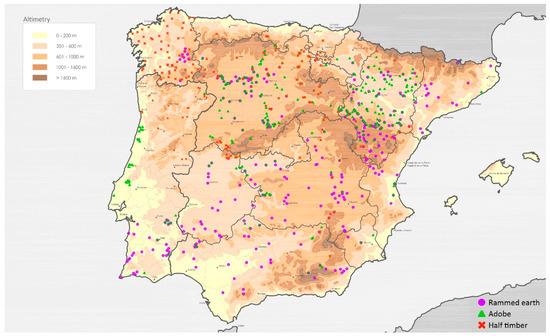
Figure 1.
Altimetry/relief and vernacular earthen techniques. Source: Own elaboration based on Dirección General de Planificación Territorial, 1994 [18].
Most of the locations in which earthen constructions have been found are at a mean altitude between 200 m and 1000 m, specifically, between 600 and 1000 m in 45% of cases (Table 1). Over 50% of the sample for each of the three constructive techniques analysed independently are predominantly found in altitudes between 600 and 1000 m. The distribution plan for rammed-earth shows how these types of constructions tend to avoid the larger mountain areas or those with higher altitudes. Despite that, this type of construction appears commonly in areas including the southeast of the Sistema Ibérico, in the province of Teruel where there are large plains at an altitude of about 1000 m, or in the region of Sierra Nevada in Granada. Adobe constructions are mostly found between 600 and 1000 m altitude, in 54.6% of cases. This is partly due to the fact that they are much more frequently found in the north of the Peninsula, where the average altitude above sea level is higher than in the south. Finally, half-timber filled with earth is more frequently found at altitudes between 600 and 1000 m, although at higher altitudes it is more frequent than rammed-earth or adobe (15.7% of cases from 1000 to 1600 m) due partly to the higher proportion the presence of forests providing wood for their construction in these higher altitude areas.

Table 1.
Relation between location of earthen construction techniques and altimetry.
4.1.2. Relation with Major Rivers
Traditional architecture has always been linked to its surroundings, making use of their resources, especially water, which is crucial for life and settlements. The location and way in which population nuclei are grouped together are closely linked to the water resources of each place. These resources are usually limited in the Mediterranean climate and more abundant in the Oceanic climate, thus allowing a more dispersed, sprawling architecture (Figure 2).

Figure 2.
Earthen architecture in the South of Murcia region. Source: authors.
Earthen architecture is often linked to rivers and is located nearby or at a minimum safe distance to protect from floods. However, there is a great wealth of other hydric resources such as irrigation channels, gullies, small rivers, streams and other natural sources that provide a relatively constant water supply but are not reflected in this mapping. This is why 32% of the locations with earthen buildings are linked to or located near the major rivers of the Iberian Peninsula, while the rest are located near other types of resources (Figure 3). In 40% of cases, rammed-earth is located near the major rivers, followed by adobe in 33% of cases and half-timber in 23% of cases (Table 2). The presence of half-timber near rivers is less frequent, probably because it is found more in mountainous areas than in river valleys. In these cases, water was obtained from other sources such as streams, springs or gullies.
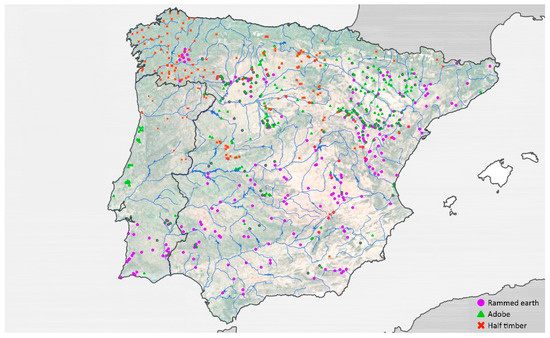
Figure 3.
Landscape, rivers and vernacular earthen techniques. Source: Own elaboration based on the Atlas Nacional de España [18] and Google Maps.

Table 2.
Relation between location of earthen construction techniques and river flows.
4.2. Climate Factors
4.2.1. Rainfall
The rainfall level in the Iberian Peninsula varies, with limited rainfall ranging from 300 to 700 mm on average in most of the territory (Figure 4). These rainfall levels are closely linked to the relief of the different regions, with heavier rainfall usually found in mountainous areas and the northwest of the Peninsula, due to the influence of the Atlantic Ocean. In terms of architecture, rainfall levels directly affect the configuration of population nuclei and their architecture, especially in the design of roofs which drain off rainwater. In regions with considerable rainfall roofs are sloping with eaves large enough to keep the walls free of water and protect from erosion. Therefore, the suitable conservation of roofs and the use of more water-resistant materials in the foundations are indispensable for the suitable conservation of the building [19].
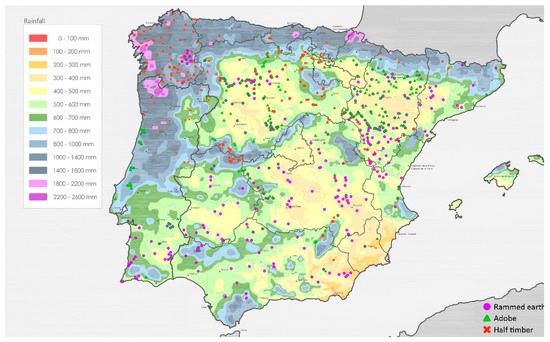
Figure 4.
Rainfall and vernacular earthen techniques. Source: Own elaboration based on the Atlas Climático Ibérico [20].
Rainfall is one of the determining factors in the existence of earthen constructions as it is one of the main causes of deterioration, and is therefore directly linked to durability. The absence of earthen architecture in areas with very high rainfall is particularly notable in the case of rammed-earth, rarely found in areas with rainfall above 700 mm, often linked with mountainous areas and areas influenced by the Atlantic Ocean (Table 3). The vast majority (91.9%) of locations with rammed-earth are in areas with an average rainfall of 300–700mm, and almost half of these cases, 47.7% are notably within the 400–500mm interval.

Table 3.
Relation between location of earthen construction techniques and rainfall.
Eight-six percent of adobe is also found in the same 300–700mm interval. However, the percentage of examples in areas with rainfall above 700 mm is double that for rammed-earth, that is to say, 13.3% in adobe compared to 6.8% in rammed-earth. This percentage gradually increases with the presence of adobe constructions in the central-west region of Portugal, both on the coast around the district of Aveiro and areas near the northern mountainous ranges with abundant rainfall.
The distribution of half-timber is homogeneous in all the rainfall ranges established in the map. It is predominant in the 1000–1400 mm interval with 23% and 51.6% of the total found at 800–1800 mm. The presence of half-timber in areas with rainfall intervals higher than those for rammed-earth and adobe is mostly due to the location of this technique in mountain areas, especially the Sistema Central and Cordillera Cantábrica, and its widespread presence in the northwest of the Iberian Peninsula, particularly Galicia, which is one of the areas with the highest rainfall levels.
4.2.2. Mean Temperature
Mean temperature is another factor that is directly linked to relief. In the Iberian Peninsula lower temperatures occur mostly in the north half and the higher mountain areas in the south, such as Sierra Nevada in the Sistema Bético (Figure 5). In traditional architecture, temperature is a determining factor in the placement, layout and distribution of buildings. Although techniques and materials to be used may be conditioned by the resources available, the mean temperature affects the typical configuration of walls, their thickness and protection elements used to combat the environmental factors of cold and heat and to passively achieve comfort conditions, reducing energy needs as much as possible [21].
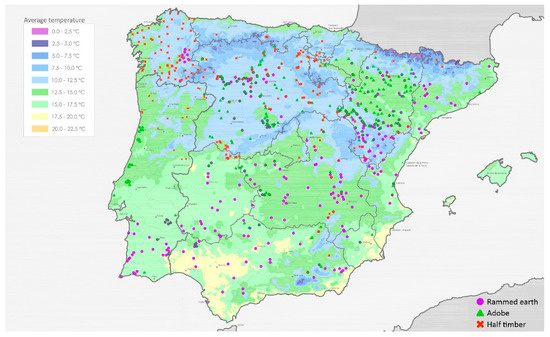
Figure 5.
Temperature and vernacular earthen techniques. Source: Own elaboration based the Atlas Climático Ibérico [20].
The high thermal inertia of earth and the thickness to which walls are usually built in this material make its use ideal in all sorts of temperatures. Thermal inertia is particularly favourable as a property for insulation and improving comfort in areas with solar radiation and major temperature oscillations from day to night as it allows heat exchange between indoors and outdoors to be regulated and stretched over time [22].
Rammed-earth is predominantly found in areas with a mean annual temperature of 10 °C–17.5 °C (93.5% of cases) and is almost inexistent in mean temperatures above 20 °C and below 7.5 °C (Table 4). Rammed-earth is used to build simple walls at least 40–50 cm thick, providing protection from oscillating cold and hot temperatures found in most of the Iberian Peninsula (Figure 6) [23].

Table 4.
Relation between the location of earthen construction techniques and mean temperature.
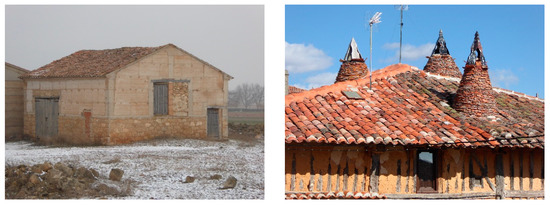
Figure 6.
Earthen architecture in cold areas. Left: Rammed-earth construction in Villarquemado (Teruel) where there is a big variation of temperatures. Right: Half-timber construction with great and numerous chimneys. Source: authors
In the case of adobe, 82.2% of locations are located in areas with mean temperatures of 10 °C–15 °C. A considerable number of examples, 11.9%, are observed up to 17.5 °C, but the presence of adobe constructions is rare in areas with mean temperatures above 17.5 °C and below 7.5 °C.
In contrast, 96.6% of locations with a presence of half-timber are in areas with mean temperatures between 7.5 °C and 15.0 °C. These temperatures are in ranges below the predominant mean temperatures for rammed-earth and adobe techniques as their construction was linked to higher mountain areas and greater intervals of annual rainfall, factors which directly influence the drop in mean temperature in these locations.
4.2.3. Climate
Climate is the “synthesis of meteorological conditions” described statistically through variability studies of its properties over a period of time [20]. The 1936 classification of climate according to Köppen-Geiger, used in this study, is based on the monthly mean values for rainfall and temperature and the influence of these factors on the distribution of vegetation and human activity [24] (Table 5). This classification defines different climate types which are the result of combining the main climates with the characteristics of rainfall and temperature (Figure 7).

Table 5.
Climate classification according to Köppen-Geiger [25].
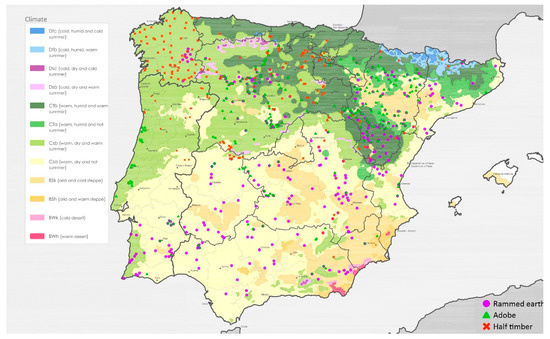
Figure 7.
Climate (period from 1971–2001) and vernacular earthen techniques. Source: Own elaboration based on the Atlas Climático Ibérico [20].
Climate in the Iberian Peninsula varies greatly as it is situated between two very different seas and two continents with very different features. The predominance of warm temperate climates (C climates) and the distribution of examples of earthen architecture in the Peninsula contribute to 86% of the sample being found in areas with these climate characteristics (Table 6). In contrast, the presence of earthen architecture is practically inexistent in in cold climates (D climates) and is limited in dry climates (B climates), where earthen constructions appear exclusively in cold steppe climates (BSk climate).

Table 6.
Relation between the location of earthen construction techniques and climate.
Most (81.4%) of the locations with rammed-earth are in warmer climate regions, especially in temperate climates with dry warm summers (Csa) (36.5%) where the mean monthly temperature of the warmest month is above 22°C. In contrast, 18% of the rammed-earth sample is located in cold steppe regions (BSk) such as the Ebro valley and the south plateau.
In addition, adobe constructions are found in regions with climate similar to that of rammed-earth, that is, 85% of the sample in temperate climates and 14.7% in cold steppe climates (BSk).
Finally, half-timber is located almost exclusively in regions with temperate climates (98.4%). Notably, in temperate climates with mild dry summers where the mean temperature for the warmest month is below 22 °C (Csb), as in 57.3% of the examples.
4.2.4. Solar Radiation
The Iberian Peninsula is characterised by high solar radiation at all latitudes, although this level of radiation decreases gradually towards the north with some irregularities caused mainly by mountain ranges (Figure 8). Traditional architecture has always sought the sun in colder seasons and protection from it in warmer seasons, taking advantage of the conditioning factors of the surroundings [26]. Earthen constructions behave similarly and also benefit from the high thermal inertia of the material and the thick walls, which protect it from direct solar incidence, absorbing heat and preventing it from entering the buildings until nighttime when the temperatures fall again [27].
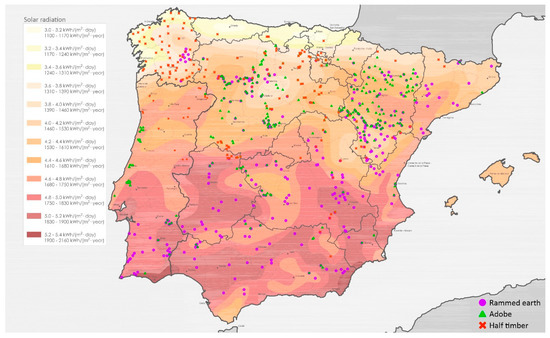
Figure 8.
Solar radiation and vernacular earthen techniques. Source: Own elaboration based on ©whisphysics.
Rammed-earth, with walls which tend to be thicker than those in adobe and half-timber due to needs of the constructive system, is the technique found in areas with higher solar radiation. The 4.2–5.2 kWh/m2·day interval includes 88.5% of cases, and 47% can be found specifically in the 4.6–5.2 kWh/m2·day interval given the greater presence of this technique in the south of the Iberian Peninsula, where the highest solar radiation ranges can be found (Table 7). The thick rammed-earth walls provide protection from solar radiation in summer, ensuring more constant temperatures are maintained inside the dwellings. In addition, in the south of the Peninsula these rammed-earth walls are often limewashed, reducing the absorption of solar radiation and promoting cooler indoor temperatures.

Table 7.
Relation between the location of earthen construction techniques and solar radiation.
Construction with adobe walls is predominant in areas with radiation intervals that are slightly lower than those of rammed-earth, from 4.0 to 4.8 kWh/m2·day, given their greater presence in the north where solar radiation is lower than in the south. The thickness of adobe walls varies greatly, depending mostly on the bonding of the wall and the size of the pieces, which vary according to the building’s intended function [28]. This variation in thickness provides different levels of resistance to the heat produced by solar radiation on the outer walls.
Half-timbered buildings are found in areas with lower solar radiation intervals; 78.1% of constructions are in the 3.6–4.8 kWh/m2·day interval and are distributed homogeneously in intermediate intervals. However, 14.6% of the total is in intervals below 3.6 kWh/m2·day, while in no cases were rammed-earth and adobe found in areas with radiation below 3.8 kWh/m2·day and 3.6 kWh/m2·day, respectively. Half-timber constructions filled with earth are not usually as thick since, in many cases, the filling between the bearers is the same thickness as the wooden pieces. The thinner walls facilitate the incidence of heat from solar radiation, regulating indoor temperature during the day as radiation and temperatures are generally lower in these locations.
4.3. Geological Factors
4.3.1. Lithology
Lithology is the aspect of geology which studies the characteristics of the rocks on the surface of the territory which are more accessible. There is usually a direct correlation between the types of rock or terrain on the surface of a given region and the materials used for building in that location, as traditional architecture makes the best use possible of available resources, avoiding unnecessary transport and reducing additional efforts in the construction process [26]. Three lithological regions can be distinguished in the Iberian Peninsula: calcareous and clayey, mostly in the east of the Peninsula and the centre-west of Portugal, while the siliceous region prevails in the west (Figure 9).
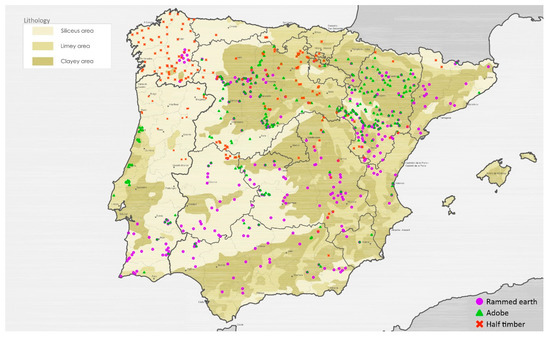
Figure 9.
Lithology and vernacular earthen techniques. Source: Own elaboration based on Solé et al. 1952 [18].
Earthen architecture is linked to the existence of clay, an element which acts as a bonding agent (48% of all locations are in clayey regions) (Table 8). However, the development of this architecture is not limited to these areas but extends to the rest of the territory (35% in siliceous surfaces and 17% in calcareous areas).

Table 8.
Relation between the location of earthen construction techniques and geological factors.
Rammed-earth is mostly found in the clayey regions (53.9%). However, the total proportion in this area is greater for adobe construction (63.5%), probably due to the greater proportion of clay needed in its production (Figure 10) [29]. This lithological relation is clearly observed in the centre-west of Portugal, an area of clayey and calcareous soil with occasional instances of adobe construction.

Figure 10.
Relationship between the ground and the earthen constructions. Left: adobe construction in Alcolea del Cinca (Huesca) build with the earth of the mountain where it is located. The building blends entirely with its surroundings. Right: rammed-earth construction in Navalpino (Ciudad Real). Source: authors.
As half-timber is dependent on the availability of wood and has a variety of fillings its relationship with local lithology is not as direct. In this case, unlike other techniques, 56.7% is mostly found in the siliceous region, given its extensive presence in the northwest of the Iberian Peninsula [30,31]. Half-timber in the clayey area accounts for 29.2% of the total, almost all of which is half-timber with adobe filling.
4.3.2. Seismicity
Seismic activity in the Iberian Peninsula is not particularly high as most of the territory is in areas with intensity below VI and 500-year recurrence periods. However, in some areas a seismic intensity of VIII is reached, which is considerable and affects aspects of architectural design.
The map (Figure 11) shows the seismic risk areas with a 500-year return period and the points with the best-known earthquakes, mostly in the southeast, northeast and northwest, considered to be of high seismic risk, compared to the low seismic risk of the rest of the Iberian Peninsula [32].
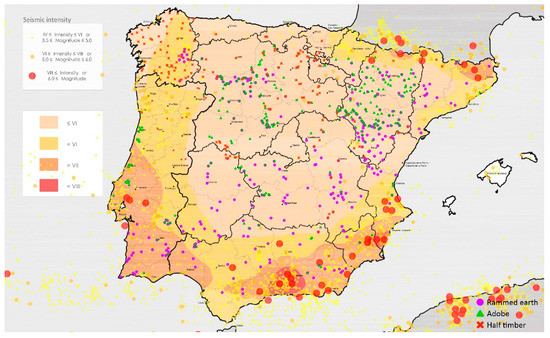
Figure 11.
Seismic intensity and vernacular earthen techniques. Source: Own elaboration based on the Atlas Nacional de España [18].
Traditional earthen architecture is mostly found (71%) in areas with seismic intensity and recurrence below VI (Table 9). As the degree of seismicity and return period are very low it is not possible to establish a direct correlation between constructive technique and seismicity. However, traditional architecture has developed variants in the constructive systems and solutions which improve the properties of buildings in the event of these phenomena, controlling movement and preventing cracks [33].

Table 9.
Relation between the location of earthen construction techniques and geological factors.
Rammed-earth is the constructive type which is found in the greatest number of locations with seismic intensity VII (12.4%) and is frequently found in the south of the Peninsula. In these areas with higher seismic activity, and especially in the case of rammed-earth, adapted solutions are found, including brackets on façades, shutters and gypsum and brick joints, which bind and reinforce buildings to control movement and prevent cracks [34].
Although examples of half-timber are not found in areas with higher seismicity in the Iberian Peninsula, 19.9% of half-timber is found in areas of intensity VI. In many cases this constructive system includes diagonal elements which help to mitigate the strain caused to structures by earthquakes, thus reducing secondary effects [33,34].
4.4. Social Factors
Population Density
Population density is one of the most influential factors in the conservation of buildings. This factor is not directly linked with the constructive technique used but with the conservation and abandonment of traditional buildings. Since the mid-20th century many rural areas in the Iberian Peninsula, mostly inland, have suffered a loss of population (Figure 12). This is partly due to the start of industrialisation which caused the population to move to the cities, as well as the high levels of poverty and abandonment in small inland towns which even today are very isolated. In addition, the harsh climate with cold dry winters and hot summers characteristic of most of the inner Iberian Peninsula meant that many of these villages became holiday locations. The new standards of comfort and the financial expense of adapting old dwellings to these have also meant that part of the population only lives in these small nuclei in the summer months.
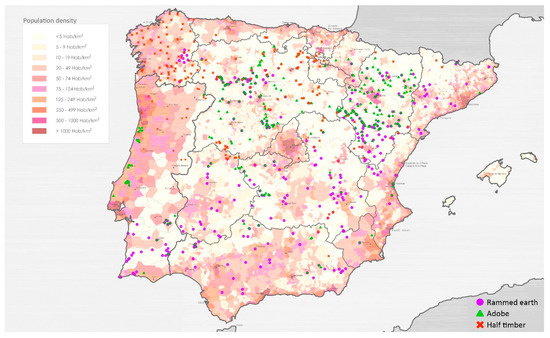
Figure 12.
Population density and vernacular earthen techniques. Source: Own elaboration based on the Atlas Nacional de España [18] and distribuição da população 2 ano, Slideshare, 2008.
Most of the traditional architecture in these almost uninhabited regions has survived, either in ruins conserved with varying degrees of deficiencies or with total or partial interventions and used as second homes. In addition, the abandonment of buildings made it possible to identify case studies where the constructive techniques can be perfectly observed. This has been to the great advantage of the research as most of it is based on direct visual data collection of buildings, identifying their main characteristics.
It is interesting to note how the areas with the highest occurrence of earthen construction located correspond to the most depopulated areas in the Iberian Peninsula (Figure 13). More than half (52.8%) of the locations with half-timber, 65.9% of rammed-earth and 65.2 % of adobe were located in areas with a density population of 20 inhab/km2 or lower. This is partly due to the wealth of earthen architecture in these areas, as well as to the fact that in areas with fewer inhabitants and numerous abandoned constructions, earthen buildings are easier to identify as protection elements or renderings have often been lost and it is possible to collect direct data objectively (Figure 14).
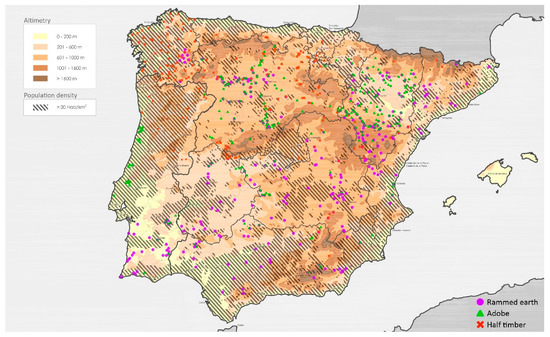
Figure 13.
Altitude, population density superior to 20 inhab/Km2 and vernacular earthen techniques. Source: own elaboration based on the Atlas Nacional de España [18] and distribuição da população 2 ano, Slideshare, 2008.

Figure 14.
Abandoned constructions in areas with low population. Left: Adobe abandoned construction in Salas de Bureba (Burgos). Rigth: Half-timber construction collapse in Calatañazor (Soria). Source: authors.
5. Geographical Factors and Earth as Material for a Sustainable Architecture
Traditional constructive techniques existing at present have evolved and developed through the optimisation of existing resources and their adaptation to their surroundings, overcoming necessity and adverse conditions. That is why earthen techniques have evolved differently in different areas and often include supplements using the material available to improve the properties and durability of the construction [21]. The existence of some techniques and the presence of those supplements on specific areas are part of the response to the geographical factors that encourage o hinder their presence in a given area.
Although earth is a material which can be found on practically any surface, it is important to examine the materials used in the architecture of a specific location to establish their suitability. As was observed in the mappings of the previous section, earthen buildings are not found all over the territory, and therefore these techniques are probably not optimal solutions in areas where they have not been used traditionally. In addition, not all types of earth are suitable for construction and extensive modification may be needed for use. If earth is finally used it is necessary to take into account factors such as rainfall, which directly affects durability, in order to provide proper protection.
The results of the analysis show different type of relationships depending on the factor. Climate factors have the greatest effect on the distribution of earthen construction techniques in the Iberian Peninsula. Given their characteristics, earthen constructions provide thermal comfort for indoor spaces which would be difficult to achieve with other materials, as they ensure temperature remains within stable ranges and they regulate the humidity in the atmosphere [35]. Although efficient, this passive conditioning system inherent to earthen construction usually requires a minimum energy supply in order to meet current standards of comfort, particularly in colder seasons. However, this need will always be less than in current standard constructions often built with prefabricated pieces and light elements.
One of the most favourable properties of earth in architecture is the thermal inertia [36], which, aided by the thickness and mass of the walls, contributes to ensuring that temperature changes are barely noticeable indoors in areas with great thermal variations, as is the case in most of the Iberian Peninsula (Figure 15a) [37]. However, this property, which notably improves indoor thermal comfort and energy savings, is not contemplated in current regulations, which only consider the transmittance of materials [38].

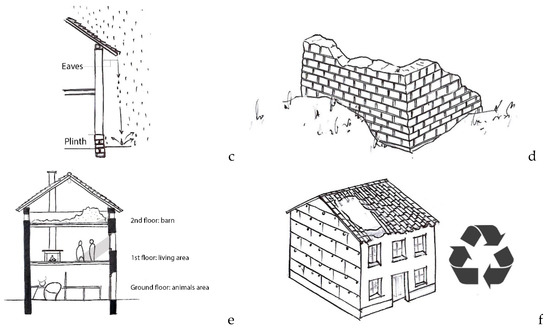
Figure 15.
Design strategies and important factors to take into account using earth as a building material. (a) Thermal inertia is one of the most beneficious thermal properties of earth construction. (b) Thick walls protect the interior of the building from sunlight in summer but allows it to penetrate in wintertime. (c) Earth building must include an adequate protection, especially against water. (d) Earth buildings go back to earth when they are destroyed without polluting the environment. (e) Example of the spatial distribution in some of the cold areas of the Iberian Peninsula. (f) The conservation of traditional buildings is a recycle or reuse of the existing materials lengthening the life span.
In terms of solar radiation, along with fire, sun was the main source of heat until the appearance of climatisation systems. The many hours of high intensity solar radiation in the Iberian Peninsula are of advantage for heating indoor spaces in winter, while in hotter climates protection is also needed from solar radiation. In warmer climates, like those of the south of the Iberian Peninsula, constructive techniques (generally rammed-earth) protect the interior from direct sunlight, while the position and size of façade openings ensure the entry of sun in winter, while in summer the overhang of the wall protects from the incidence of sunlight (Figure 15b).
Finally, rainfall is one of the factors which levels are directly linked to existence of earthen construction techniques. The mappings show how rammed-earth and adobe particularly are distributed throughout the territory. However, these techniques are rarely found in areas with heavy rainfall. Therefore, it is very important to take into account rainfall levels due to there are locations where the use of these techniques is less advisable and potential use would require elements to protect and prevent the premature degradation of the building (roofs with broad eaves, renderings, foundations, etc.) (Figure 15c).
On the other hand, the relationship between geological factors and earthen techniques is not so clear on the Iberian Peninsula. Lithology is related to the characteristics of available materials and the location of earthen construction is predominant in clayey areas, but the usage of this material is also linked to the water flows or river courses where clay particles are deposited. That is one of the reasons why the use of earth is spread all over the territory. On the other side, seismicity is not a relevant factor on the existence of earth construction in the peninsula as the seismic areas are reduced and the main focuses are located in the perimeter of the territory.
As seen, geographical factors affect differently to the earthen techniques due to their heterogeneity. Based on the analysis it is possible to detect that the presence of each technique is not restricted to areas with specific characteristics but their presence is more noticeable in some ones. This means, for example, that in areas with reduced rainfall where usually there is earthen architecture, other factors such as seismicity, altitude or the predominance of other materials as stone can produce a restriction on its use. Thus, this study must be considered as a general framework in which there would be exceptions.
The scale of the territory linked to the closest environment, together with the analysed geographical aspects and the cultural aspects, determine the final characteristics of the traditional architecture. Those constraints are the ones that make traditional architecture sustainable by definition.
The use of earth as a construction material is in many ways a sustainable solution that is respectful of the environment. None of the techniques analysed (rammed-earth, adobe and half-timber) require high temperatures to produce the material or the elements that compose it, with high CO2 savings in construction [39]. In addition, earth is a material found almost everywhere and usually easily accessible, so that little or no transport is needed depending on specific cases. Finally, when this material is degraded it returns to the earth it was part of without polluting (Figure 15d).
The energy cost of construction is an ecological indicator which takes into account CO2 consumption and emissions in all phases of the construction process, from manufacturing and sourcing of materials to their durability [40]. Therefore, it is important to use materials and techniques that are closely connected to the location they are found in, as this reduces both environmental impact and economic cost.
In turn, a sustainable design is closely linked to the potential level of energy efficiency of the building. Factors, such as position in relation to surroundings, orientation, characteristics and size of façade openings, use of different rooms or natural ventilation that are greatly considered in traditional architecture, have often been forgotten and ignored in contemporary architecture (Figure 15e). It is therefore important to study the composition of traditional buildings which, albeit with much lower habitability standards, provided spaces with minimal or no energy contributions depending on the geographical area and particularly its morphology and climate [41]. The study of the thermal behaviour of the building and the energy losses it is important to understand the requirements to meet the actual comfort levels [42,43]. With that purpose, data as geographical location, climate factors and orientation of the building must be taken into account.
On the other hand, the conservation of traditional architecture shows the way to sustainability at present. This is especially true of the conservation of earthen architecture based on the premise of its suitability for use and for reaching the current levels of comfort, offering a great opportunity to combine the aspects of environmental, sociocultural and socioeconomic sustainability [44]. The study of these buildings in disuse is important in promoting their conservation and the reuse of a traditional architecture which would otherwise be condemned to disappear. In addition, traditional earthen architecture in the Iberian Peninsula is a very important and irreplaceable building heritage which makes up an extensive documentary body with much information still to be extracted and many trades and techniques to be learnt. Therefore, the conservation of these buildings is the conservation of a historic document, as well as the reuse of space and materials which would otherwise disappear and involves recycling materials which have already been transformed into construction materials, one of the most important premises for sustainability (Figure 15f).
In order to design a sustainable architecture either through interventions on a preexisting element or on a new building, the lessons in sustainability, resource optimisation and adaptation to the surroundings provided by traditional architecture cannot be ignored [44]. This makes it interesting to note the constructive techniques developed in each location, as well as their composition and design. The learning and implementation of the know-how of each location and the values and properties of traditional architecture are very important in the construction of new buildings, as it makes use of the techniques and materials that can be accessed on site, with minimum transport. Along with current innovations, these can bring about a notable reduction in the environmental impact compared to the most commonly used construction systems at present. In addition, by taking into account all these factors, it would be possible to achieve social, financial and cultural, as well as energy sustainability [45].
6. Conclusions
Earthen construction has traditionally been used in almost all of the Iberian Peninsula. Earthen construction techniques have gradually adapted and been optimised depending on the varied geography of this territory, mainly appearing to cope with factors with very different properties, showing the high resistance and adaptability of these techniques.
Although the constructive techniques analysed (rammed-earth, adobe and half-timber filled with earth) are found simultaneously in most of the territory, half-timber stands out from the other two.
Climate factors, which are closely linked to morphological factors, are the most influential ones on the development of earthen architecture on the peninsula. In this group rainfall and mean temperature are the ones whose influence is more noticeable in earthen architecture.
Within this framework, the rammed-earth technique is the one that appears in regions with a warmer climate (more sun, less rain and a higher mean temperature), while adobe is common in areas with less solar radiation and lower temperatures (especially in winter) mostly in the north half of the Iberian Peninsula—and even in some cases, in areas with slightly heavier rainfall.
On the other hand, half-timber is the technique located mostly in the North of the peninsula in areas with higher altitude, lower mean temperatures, heavier rainfall and less solar radiation than the ones where adobe and rammed-earth are located.
Besides knowing which earthen techniques are more suitable throughout the territory of the peninsula, there are some morphological and landscape aspects that must be taken into account when traditional architecture is analysed. This is why, both for the conservation of traditional earthen construction as well as for new buildings, it is very important to carry out a preliminary analysis of the traditional architecture in the area where these are to be located.
The response to specific environmental constraints and the usage of materials from nearby areas make this architecture to be built documents. They have adapted to their surroundings optimising resources to meet functional needs, and so they can reveal many of the keys to sustainable construction.
Author Contributions
For research articles with several authors, a short paragraph specifying their individual contributions must be provided. The following statements should be used “conceptualization, C.M.; L.V.C. and L.G.-S.; methodology, C.M.; L.V.C.; F.V.L.-M. and L.G.-S.; software, L.V.C.; validation, L.V; formal analysis, L.V.C. and L.G.-S.; investigation, L.V.C.; resources, C.M.; F.V.L.-M.; L.V.C. and L.G.-S.; data curation, L.V.C.; writing—original draft preparation, L.V.C.; writing—review and editing, F.V.L.-M. and C.M.; visualization, L.V.C. and L.G.-S.; supervision, F.V.L.-M.; C.M. and L.G.-S.; project administration, L.G.-S. and C.M.; funding acquisition, C.M. and F.V.L.-M.”.
Funding
This work is part of the research project “Restoration and rehabilitation of traditional earthen architecture in the Iberian Peninsula. Guidelines and tools for a sustainable intervention”, funded by the Spanish Ministry of Economy and Competitiveness (Ref.: BIA2014-55924-R; main researchers: Camilla Mileto and Fernando Vegas López-Manzanares).
Conflicts of Interest
“The authors declare no conflict of interest”. “The funders had no role in the design of the study; in the collection, analyses, or interpretation of data; in the writing of the manuscript, or in the decision to publish the results”.
References
- Mileto, C.; Vegas, F.; Villacampa Crespo, L.; García-Soriano, L. Vernacular earthen architecture in the Iberian Peninsula. First phase of taxonomy and geographical distribution. In Proceedings of the Ninth International Earthbuilding Conference-Earth USA 2017, Santa Fe, NM, USA, 29 September–1 October 2017; pp. 102–107. [Google Scholar]
- Correia, M.; Merten, J.; Vegas, F.; Mileto, C.; Cristini, V. Earthen architecure in Southwastern Europe: Portugal, Spain and Southern France. In Terra Europe: Earthen Architecture in the European Union, 1st ed.; Correia, M., Dipasquale, L., Mecca, S., Eds.; Edizioni ETS: Pisa, Italy, 2011; pp. 71–75. [Google Scholar]
- AA.VV. Terra Incognita: Discovering & Preserving European Earthen Archtiecture; Tervuren: Culture Lab Éditions, Ed.; Argumentum: Lisbon, Portugal, 2008. [Google Scholar]
- AA.VV. Criterios de intervención en la arquitectura de tierra. Proyecto Coremans; Ministerio de Economía Cultura y Deporte: Madrid, Spain, 2017.
- Gómez Patrocinio, F.J. Arquitectura tradicional de tierra en España. Caracterización constructiva, fenómenos de degradación y dinámicas de intervención; Universitat Politècnica de València: Valencia, Spain, 2018. [Google Scholar]
- AA.VV. La restauración de la tapia en la Península Ibérica. Criterios, técnicas, resultados y perspectivas; Mileto, C., Vegas, F., Eds.; Argumentum Ediçóes: Lisbon, Portugal; TC Cuadernos: Valencia, Spain, 2014. [Google Scholar]
- AA.VV. Earthen Architecture in Portugal; Fernandes, M., Correia, M., Eds.; Argumentum: Lisbon, Portugal, 2005; pp. 45–49. [Google Scholar]
- AA.VV. Terra Lyon 2016; Éditions CRAterre: Villefontaine, France, 2017. [Google Scholar]
- AA.VV. Rammed Earth Conservation; Mileto, C., Vegas, F., Cristini, V., Eds.; Balkema Taylor and Francis Group: London, UK, 2012. [Google Scholar]
- AA.VV. Earthen Architecture: Past, Present and Future; Mileto, C., Vegas, F., García, L., Cristini, V., Eds.; Balkema Taylor and Francis Group: London, UK, 2015. [Google Scholar]
- AA.VV. Vernacular and Earthen Architecture. Conservation and Sustainability; Mileto, C., Vegas, F., García, L., Cristini, V., Eds.; Balkema Taylor and Francis Group: London, UK, 2018. [Google Scholar]
- AA.VV. 16º Seminario Iberoamericano de Arquitectura y Construccion con Tierra (SIACOT); Red Proterra, Ed.; Facultad de Arquitectura, Diseño y arte: Asunción, Paraguay, 2016. [Google Scholar]
- AA.VV. Vernacular Heritage and Earthen Architecture; Correia, M., Carlos, G., Rocha, S., Eds.; Balkema Taylor and Francis Group: London, UK, 2013. [Google Scholar]
- Mileto, C.; Vegas López-Manzanares, F.; García-Soriano, L.; Villacampa Crespo, L.; Gómez Patrocinio, F.J. Primera aproximación a la variedad constructiva de la arquitectura vernácula de tierra en la Península Ibérica. In Proceedings of the X Congreso Nacional y II Congreso Internacional Hispanoamericano de Historia de la Construcción, San Sebastián, Spain, 3–7 October 2017; Available online: http://www.sedhc.es/biblioteca/actas/Mileto.pdf (accessed on 30 January 2018).
- Font Mezquita, F.; Hidalgo, P. La tapia en España. Técnicas actuales y ejemplos. Informes de la Construcción 2011, 63, 21–34. [Google Scholar] [CrossRef]
- Canivell, J.; Rodríguez García, R.; González Serrano, A.M.; Romero Girón, A. Vernacular rammed earth builng typologies in the ancient reign of Seville, Spain. In Proceedings of the Vernacular Heritage and Earthen Architecture (CIAV), Balkema, London, UK, 16–20 October 2013; pp. 117–122. [Google Scholar]
- Font Arellano, J. La présence de l’adobe en Espagne. In Les Cultures Constructives de la brique crue; de Chazelles, C.A., Klein, A., Pousthomis, N., Eds.; Éditions de l’Esperou: Montpellier, France, 2011; pp. 205–212. [Google Scholar]
- Instituto Geográfico Nacional; Ministerio de Fomento. Atlas Nacional de España 1986–2008; Centro Nacional de Información Geográfica, Madrid, Spain. Available online: http://www.ign.es/ane/ane1986-2008/ (accessed on 5 May 2016).
- Doat, P.; Hays, A.; Houben, H.; Matuk, S.; Vitoux, F. Construir en terre; CRATerre, Ed.; Éditions Alternative et Parallèles: Paris, France, 1979; Available online: https://craterre.hypotheses.org/319 (accessed on 15 December 2018).
- Agencia Estatal de Meteorología; Instituto de Meteorología de Portugal. Atlas Climático Ibérico; Ministerio de Medio Ambiente y Medio Rural y Marino: Madrid, Spain, 2011. Available online: https://www.aemet.es/documentos/es/conocermas/publicaciones/Atlas-climatologico/Atlas.pdf (accessed on 4 May 2016).
- Beckett, C.; Ciancio, D. A review of the contribution of thermal mass to thermal comfort in rammed earth structures. In Proceedings of the 2nd International Conference on Sustainable Built Environment, University of Peradeniya, Kandy, Sri lanka, 14–16 December 2012. [Google Scholar]
- Wilson, Q.; Higbee-Barzola, K.; Stickney, B.; Friedman, G. When thermal mass becomes resistance. In Proceedings of the LEHM 2016: Tagungsbeitrage der 7 Internationalen Fachtagung fur Lahmbau, Weimar, Germany, 12–14 November 2016. [Google Scholar]
- Childs, K.W.; Courville, G.E.; Bates, E.L. Thermal Mass Assessment; Oak Ridge National Laboratory: Oak Ridge, TN, USA, 1983.
- Essenwanger, O.M. General Climatology 1C: Classification of Climates; Elsevier: Amsterdam, The Nertherlands, 2001. [Google Scholar]
- Kottek, M.; Grieser, J.; Beck, C.; Rudolf, B.; Rubel, F. World Map of Köppen-Geiger climate clasification updated. Meteorologische Zeitschrift 2006, 15, 259–263. [Google Scholar] [CrossRef]
- AA.VV. Versus: Lessons from Vernacular Heritage to Sustainable Architecture; CRAterre/ESG/UNICA/UNIFI/UPV, Ed.; 2014; Available online: https://www.esg.pt/versus/pdf/versus_booklet.pdf (accessed on 19 December 2016).
- Dincyurek, O.; Mallick, F.H.; Numan, I. Cultural and environmental values in arcaded Mesaorian houses of Cyprus. Build. Environ. 2003, 38, 1463–1473. [Google Scholar] [CrossRef]
- García-Soriano, L.; Villacampa Crespo, L.; Gómez-Patrocinio, F.J. Earthen elements in the Iberian Peninsula: Cataloguing and preliminary study. In Vernacular and Earthen Architecture, 1st ed.; Mileto, C., Vegas López Manzanares, F., García-Soriano, L., Cristini, V., Eds.; Taylor and Francis: London, UK, 2018. [Google Scholar]
- Fernandes, M. Mouled Adobe. In Earthen Architecture in Portugal; Fernandes, M., Correia, M., Eds.; Argumentum: Lisboa, Portugal, 2005; pp. 45–49. [Google Scholar]
- Fernández Palicio, A. Impossible, comme construire en terre en Galice. Mémoire du dîplome de spécialisation et d’approfondissement, DSA-terre; ENSAG: Grenoble, France, 2016. [Google Scholar]
- Araújo, G. Terra sobre engradado em Portugal. In Earthen Architecture in Portugal; Fernandes, M., Correia, M., Eds.; Argumentum: Lisboa, Portugal, 2005; pp. 57–61. [Google Scholar]
- López Casado, C.; Peláez Montilla, J.A. Peligrosidad sísmica en la Península Ibérica. Revista Española de Física 2002, 16, 29–32. [Google Scholar]
- Dipasquale, L.; Sidik, D.O.; Mecca, S. Earthquake resistant structures. In Versus: Heritage for Tomorrow; Correia, M., Dipasquale, L., Mecca, S., Eds.; Firenze University Press: Firenze, Italy, 2014; pp. 232–243. Available online: https://www.esg.pt/versus/pdf/versus_heritage_for_tomorrow.pdf (accessed on 19 December 2016).
- Correia, M.; Carlos, G. Cultura sísmica local em Portugal; Argumentum: Lisboa, Portugal, 2015; Available online: https://esg.pt/seismic-v/assets/uploads/2015/10/seismic_v_cultura_sismica_local.pdf (accessed on 12 December 2017).
- Parra-Saldivar, M.L.; Batty, W. Thermal behaviour of adobe constructions. Build. Environ. 2006, 41, 41–1982. [Google Scholar] [CrossRef]
- De Cárdenas y Chávarri, J.; Maldonado Ramos, L.; Barbero Barrera, M.M.; Gil Crespo, I.J. Sostenibilidad y mecanismos bioclimáticos de la arquitectura vernácula española: El caso de las construcciones subterráneas. In Proceedings of the 14 Convención científica de ingeniería y arquitectura, Cujae, La Habana, Cuba, 1–5 December 2008; Available online: http://oa.upm.es/5649/ (accessed on 17 November 2017).
- Minke, G. Building with Earth: Design and Technology of a Sustainable Architecture; Birkhäuser: Basel, Switzerland, 2006; p. 30. [Google Scholar]
- Dirección General de Arquitectura, Vivienda y Suelo. DA DB-HE/1 Cálculo de parámetros característicos de la envolvente. In Código Técnico de la Edificación; Ministerio de Fomento: Madrid, España, 2015. Available online: https://www.codigotecnico.org/images/stories/pdf/ahorroEnergia/DA-DB-HE-1-Calculo_de_parametros_caracteristicos.pdf (accessed on 30 January 2018).
- Gonzalez, M.; García Navarro, J. Assessment of the decrease of CO2 emissions in the construction field through the selection of materials. Build. Environ. 2006, 41, 41–902. [Google Scholar] [CrossRef]
- Maldonado Ramos, L.; Castilla Pascual, F.; Vela Cossío, F. Rendimiento y coste energético en la construcción de cerramientos de fábrica de adobe y bloque de tierra comprimida. Informes de la Construcción 2001, 53, 473. [Google Scholar]
- Achenza, M.; Giovagnorio, I. Environmental sustainability in vernacular architecture. In Versus, Heritage for Tomorrow; Correia, M., Dipasquale, L., Mecca, S., Eds.; Firenze University Press: Firenze, Italy, 2014; pp. 41–47. Available online: https://www.esg.pt/versus/pdf/versus_heritage_for_tomorrow.pdf (accessed on 19 December 2016).
- Nardi, I.; Lucchi, E.; se Rubeis, T.; Ambrosini, D. Quantification of heat energy losses through the building envelope. Build. Environ. 2018, 146, 146–190. [Google Scholar] [CrossRef]
- Balaguer Garzón, L. En tierra Serrana. La restauración de la arquitectura tradicional de tierra en la comarca de La Serranía de Valencia. Estudio del comportamiento bioclimático y la eficiencia energética en las intervenciones; Universitat Politècnica de Vàlencia: Valencia, Spain, 2018. [Google Scholar]
- Vegas, F.; Mileto, C.; Guimaraens, G.; Navalón, V. Defining sustainable architecure. In Versus, Heritage for Tomorrow; Correia, M., Dipasquale, L., Mecca, S., Eds.; Firenze University Press: Firenze, Italy, 2014; pp. 35–39. Available online: https://www.esg.pt/versus/pdf/versus_heritage_for_tomorrow.pdf (accessed on 19 December 2016).
- Carlos, G.D.; Correia, M.; Dipasquale, L.; Guillaud, H.; Mecca, S.; Mileto, C.; Vegas, F.; Achenza, M.; Viana, D.; Cannas, L. Research method and operative approach. In Versus—Heritage for Tomorrow; Correia, M., Dipasquale, L., Mecca, S., Eds.; Firenze University Press: Firenze, Italy, 2014; pp. 23–31. Available online: https://www.esg.pt/versus/pdf/versus_heritage_for_tomorrow.pdf (accessed on 19 December 2016).
© 2019 by the authors. Licensee MDPI, Basel, Switzerland. This article is an open access article distributed under the terms and conditions of the Creative Commons Attribution (CC BY) license (http://creativecommons.org/licenses/by/4.0/).